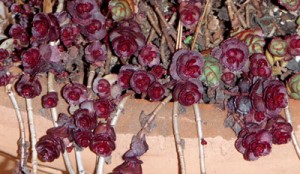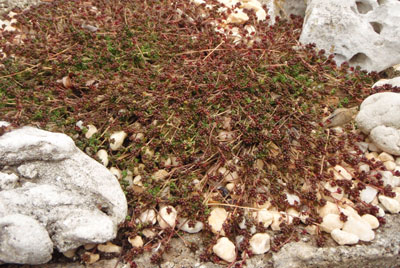Tough, adaptable sedums—there are about 100 species and countless cultivars—are the plant pick of the month for December. Best known of the lot is ‘Autumn Joy’, more correctly listed by its German name, ‘Herbstfreude’. This familiar and adaptable perennial produces flowers that look like great clumps of broccoli when they first appear in the garden. In late summer and early fall, the flat-topped pink, then pinky bronze, clusters provide perfect landing platforms for countless butterflies and beneficials. After blooming, the flowers ripen to burgundy-brown. On this dreary December day, however, I’m going to concentrate on plants of lower stature, namely ground-covering sedums that are still adding color to the garden here at Hackberry Point.
One of the showiest sedums in my garden this month is S. rupestre ‘Angelina’. It produces clumps of lax stems covered with cylindrical leaves that reach about 4 inches in height. The yellow, summer-borne flowers aren’t much to write home about, but the foliage is simply stunning. Leaves at the tips of the stems are yellow and turn gold to deep bronzy orange in fall and winter. The contrast is especially effective because the leaves on the lower part of the stems are bronzy green. Plants are evergreen in the south; deciduous in the north. Like most sedums, ‘Angelina’ delivers its measure of color to the garden with a minimum of fuss and bother, too, since plants tolerate drought, poor soil, heat, and humidity.
Before you plant, though, be aware that ‘Angelina’ spreads quickly.This is one of the sedums that fall into my “be afraid, be very afraid” category of ground covers. Internet claims that a 3-inch plant spreads to 2 feet in a single season are not exaggerating. What they don’t mention is how far the plant spreads in subsequent years, or the fact that every single little piece of plant you drop will root as well. For this reason, careful siting is essential if you and ‘Angelina’ are going to have a happy relationship. Thus far, the site I’ve chosen is working out. I’m using ‘Angelina’ as a ground cover in one of my shrub borders, where it’s growing on a hot, dry slope that never gets watered. The site is bordered with a gravel driveway on one side and shrubs on the other, so it’s free to spread but can’t really escape. By next season, it will have filled in around nearby junipers and variegated Yucca.
Two-row sedum (S. spurium) is another common ground cover. While I’ve no interest in growing the all-green species, I’ve kept two cultivars of growing in a container this year because I didn’t have space graded and ready to plant. Even in November, both green-, pink-, and white-leaved ‘Tricolor’ and maroon-leaved ‘Voodoo’ still add some foliage color to the garden, although they’re not as handsome as they were in midsummer. Both also are fast spreaders that need to be sited carefully. I’m still pondering where I’ll plant them permanently. Undoubtedly a part of each clump will end up around the shrubs in my border. ‘Tricolor’ and ‘Voodoo’ actually made a handsome, low-maintenance container combination this summer, especially before I moved a third resident of their container to the garden: handsome blue-green leaved October daphne (S. sieboldii). Both S. sieboldii and another favorite ‘Vera Jameson’ are clump-forming sedums that contribute brilliant pink flowers to the fall garden. By November, though, both these deciduous sedums have faded into winter dormancy.
Most sedums—‘Angelina’, ‘Tricolor’, and ‘Voodoo’ included—are great plants for this economy. Plant them and they will spread. For all three, I started with a small plant, and after only a season I have nice-size clumps that can be divided if I want to experiment with sedums somewhere else in the garden. Perhaps I’ll try some of these more vigorous selections along the top of the wall in the front garden or right in the edges of the gravel driveway. I also plan to keep pieces to use as ground covers under other larger plants in containers.
Two other evergreen sedums that have happily spent the summer in containers also still feature attractive foliage. The first, ‘Blue Balls’ produces round tufts of tiny blue leaves and are really appealing combined with interesting rocks as well as hen-and-chicks (Sempervivum spp.) and other rock garden plants that thrive average to dry, well-drained soil. It’s not much of a spreader: My plant is perhaps 8 inches across from a 2-inch pot planted in spring.While I’m moving some of my clump to the garden proper in spring, ‘Blue Balls’ is so stunning in a container I’m sure I’ll keep some for a trough or pot.
The other tiny sedum I enjoyed all summer long is S. rubrotinctum ‘Mini Me’, which bears round, pin-head size green leaves on sprawling stems. It spreads more than ‘Blue Balls’, but I can’t think of many plants it could overwhelm—and many that would overwhelm it. The foliage turns maroon in fall. I’ll be using some of my now fairly sizable stash of it again in a trough next summer, but will also plant some with my sempervivums and smaller thymes. ‘Mini Me’, which is about ½ inch tall, would make a nice ground cover over miniature bulbs, too.
Finally, I did want to include a word about another favorite sedum that isn’t looking its best in this colder weather: wild stonecrop (Sedum ternatum). It’s a native species found from New Jersey south to Georgia and west to Iowa. For gardeners, the big news is that it thrives in partial shade to shade and dry soil, although plants also thrive in moist, well-drained conditions. Rounded medium green leaves are topped by clusters of starry white flowers in late spring and early summer. Plants range from 4 to about 8 inches tall. It’s simply a great native that should be in more gardens!
If this is your first time visiting GGW Plant Pick of The Month, I hope you’ll participate. When posting comments on GGW, put a link to your site with photos of sedums you’ve used in your garden. Thoughts, ideas, siting suggestions, successes, failures, likes and dislikes are what we love to hear about from you….and anything else you want to share!




